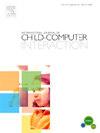How fiction can support the teaching of societal implications of emerging technologies? A case study on facial recognition activities with K-9 students
Q1 Social Sciences
International Journal of Child-Computer Interaction
Pub Date : 2025-08-14
DOI:10.1016/j.ijcci.2025.100768
引用次数: 0
Abstract
We report from a fiction-based teaching activity in K-9 education in which 41 students (aged 13-15 y) were taught about the societal implications of emerging technologies – in this case, facial recognition technologies. Whereas current Child-Computer Interaction research primarily focuses on technical and conceptual aspects of emerging technologies in K-9 education, less emphasis has been put on the societal implications of emerging technologies. This is due to the complexity of these societal implications for K-9 students, the typical separation of technical and societal elements in K-9 teaching, as well as the influence of assumptions regarding technology implications. Based on prior Child-Computer Interaction research on fiction-based activities in educational contexts, we demonstrate how fiction-based activities can be useful to overcome the current challenges of teaching about societal implications of emerging technologies. Our study demonstrates how fiction-based activities can expose students to different stakeholders' perspectives and develop nuanced opinions about ethical and societal implications of emerging technologies. However, there were aspects that were not fully supported by the approach, like students' understanding of algorithmic bias and connection to real-life scenarios. Our research results also generated a list of important questions to be addressed by future Child-Computer Interaction research to fully embrace the potential of fiction-based activities in regard to emerging technologies’ societal implications within K9 education.
小说如何支持新兴技术对社会影响的教学?小九学生面部识别活动的个案研究
我们报告了一项基于小说的K-9教育教学活动,其中41名学生(13-15岁)被教导新兴技术的社会影响-在这种情况下,是面部识别技术。当前的儿童-计算机交互研究主要集中在K-9教育中新兴技术的技术和概念方面,而对新兴技术的社会影响的重视较少。这是由于对K-9学生的社会影响的复杂性,K-9教学中技术和社会因素的典型分离,以及关于技术影响的假设的影响。基于先前关于教育背景下基于小说的活动的儿童-计算机交互研究,我们展示了基于小说的活动如何有助于克服当前关于新兴技术的社会影响的教学挑战。我们的研究展示了基于小说的活动如何让学生接触到不同利益相关者的观点,并就新兴技术的伦理和社会影响形成微妙的观点。然而,有一些方面并没有得到该方法的完全支持,比如学生对算法偏见的理解以及与现实生活场景的联系。我们的研究结果还产生了一系列重要的问题,这些问题将在未来的儿童-计算机交互研究中得到解决,以充分利用基于小说的活动在新兴技术对K9教育的社会影响方面的潜力。
本文章由计算机程序翻译,如有差异,请以英文原文为准。
求助全文
约1分钟内获得全文
求助全文
来源期刊

International Journal of Child-Computer Interaction
Social Sciences-Education
CiteScore
7.20
自引率
0.00%
发文量
73
 求助内容:
求助内容: 应助结果提醒方式:
应助结果提醒方式:


